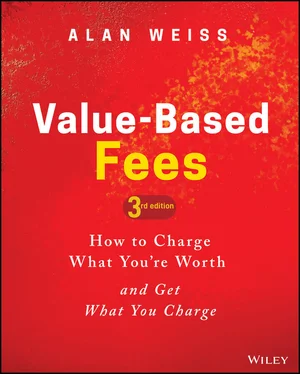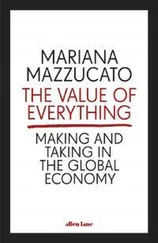Most of the conventional working trades—plumbers, electricians, carpenters, and the like—have placed a premium on their time.
Time is the universal objective, in that the client and the consultant can agree on the length of an hour or a day. (Of course, how much of that duration is spent on qualitative work is another matter entirely.)
Consultants have had a ready-made lever for increasing their business by merely increasing their time investment.
One's consulting worth was usually perceived as the same as one's physical presence, thereby attaching worth to “showing up.” It was easy to attach a fee to that presumed worth: “If I'm here, I must be helping, so I ought to be paid.”
The uncertainty of the work required that the consultant “protect” future time by charging for all time spent, since there was no firm way of predicting how much time would be required, what new and unforeseen developments might affect the project, or what increasing demands the client might come up with. The belief was that time spent on one client was irretrievably lost and was therefore denied another client (and another client's potential fee).
Seeing that consultants offer advice for long-term enrichment, why charge for short-term visits? My recommendations are worth far more than my presence.
Finally, there seems to be a widespread belief, unaccountably held to most dearly by the larger consulting firms, that the only consulting items of value are either time or materials (deliverables) and that clients wouldn't pay for anything as ephemeral as pure advice. Of course, stated that way, this proposition is true. The point, however, is that clients will pay a great deal for the outcomes, results, and long-term value of that advice.
And that value has nothing whatsoever to do with time. If I solve your problem and create an innovation in one day that you can immediately begin realizing the value of, isn't that worth far more than my taking three months and denying you a quarter year of improvement? That's why charging by a time unit is unethical, pure and simple.
SUPPLY-AND-DEMAND ILLOGIC
One of the worst pieces of advice I ever heard was from a professional speaker who pontificated to the audience that speakers should “raise fees when demand exceeds supply.” That might work for soybeans or cement, but it's simply goofy when applied to professional services.
Demand never exceeds supply. Not only do I know of no consultants who are booked every day of the year, but I can't imagine any who would want to be, since real wealth is discretionary time. The idea, I always thought, was to work a minimal amount of time while earning a maximum amount of money. (My ideal client is one who pays me $5 million to work for 20 minutes a year. My wife points out that if I can work for 20 minutes, I can certainly manage 40 minutes.)
Moreover, supply and demand rest on the trembling foundation that a single client at a single time usurps all attention. It is possible to do something for multiple clients at any given time: research, joint meetings, newsletters, focus groups, interviews, and a plethora of other activities can benefit numerous clients in unique ways. (The lawyers achieve this by billing different clients for an aggregate of hours that only slightly exceeds by a factor of four the total number in any one solar day.)
My personal record is 38 active clients at one time.
The idea is to meet demand with a minimal supply of labor and, in fact, meet growing demand by an increasingly diminishing investment of time. This is called working smart, not hard.
There are actually formulas that advise that consultants take the following steps:
1 Determine the amount of money they need to support their total lifestyle.
2 Calculate the total number of hours available to consult during a year, eliminating holidays, personal needs, and so on.
3 Determine an approximate usage rate for the remaining time (for example, what percentage of time will the consultant probably be booked, given the marketplace and focus?).
4 Divide the result of the usage rate applied to the net available hours by the lifestyle needs total. This gives the hourly rate needed to meet financial goals within the given time constraints.
Now, there are only about 70 or 80 things wrong with this, but I'll concentrate only on the relative few needed to thoroughly debunk this point of view.
First, it's absolutely nuts to use your current lifestyle (or even an intended lifestyle) as the basis for income needs. What about unanticipated expenses (illnesses, extended family needs, unexpected opportunities to invest, and so on)? Especially for younger consultants (or for anyone without fully funded, totally comfortable retirement savings), why delimit yourself during your highest potential earning years?
Second, how do you intelligently arrive at a number of hours you think are available? The number will always go down from that estimate, never up, meaning that your hourly rates will be inadequate and you'll either have to raise them or take more hours from “private time.” Time is always usurped by the unforeseen, which, by definition one would think, can't be forecast. (This is the currently fashionable “black swan” phenomenon.)
Third, approximations of usage rates are absurd because high rates aren't necessarily good. It's simply not smart to be booked 80 percent or more of the time, because your flexibility is eliminated (just as any good medical consultant will tell a medical practice not to book all available hours every week but to set aside time for emergencies and other exigencies). Wouldn't we all rather work less for fascinating clients who pay us well rather than more for dull clients who pay us poorly?
I was at a speaking convention as one of the plenary speakers, and I was playing hooky until my speech the following day. I was at the pool with only one other person present, a woman I didn't know. I'm lousy at small talk, but her magazine blew away and I retrieved it. I asked if she was a speaker, since I couldn't think of anything else to say.
“No, my husband,” she said. “I come to the convention because he travels so much that this is a time I can be with him.”
But where was her husband? I looked into the pool to see if he had drowned. “He's in a workshop he didn't want to miss,” she continued, “but he'll be back for dinner.”
“How much does your husband travel?” I asked
“He presents 120 time a year, so he travels about 240 days.”
I was stunned at this. “May I ask how much he charges?”
“One thousand dollars a day, plus expenses.”
“May I offer you a suggestion?” I asked, but simply continued before she could answer, “If he doubled his fee he could travel only half as much and you'd have an even better lifestyle.”
She laughed. “Oh, he could never get that much,” his faithful wife responded.
This is the problem with charging for your presence and having poor self-esteem. It's called “the poor house.”
Fourth and finally, the resultant hourly rate in the equation has no bearing on the market, the client need, the unique conditions, or the value of the help delivered. It reduces the consultant to an arbitrary commodity, to be compared to other hourly rates and other commodities, like fish or movie tickets. When you deliberately remove market uniqueness and differentiation, you also remove the basis for high fees.
The last thing a good consultant wants to happen is for a client to make comparisons based not on the value of the contribution but rather on the charge per hour. Our value is simply not conveyed by merely showing up (thank goodness).
So the very basis for a “supply and demand” dynamic is fallacious. We do not have a limited supply of expertise, nor do we seek higher and higher demand (not if we want to maintain a life). What we should want to accomplish is an ideal relationship of interesting, growth-oriented work and fees based on our contribution to the clients' results.
Читать дальше












